Introduction
A web business opens the world's front doors and raises the stakes. From the traditional jewelry artisans of Jaipur to technology stores of New York, customers everywhere crave the same: immediate, seamless service that is customized. Miss a beat, and there is little tolerance.
More web traffic means more levels of assistance requests: orders, payments, returns, product availability, and so forth. Soon, it will be too much to hand-process all of these. Anyhow, hiring more customer support personnel is just a short-term fix that demands significant time, training, and continuing investment.
An intelligent path forward? AI-powered chatbots for e-commerce customer support.
Eliminating protracted wait times and a large support staff, these smart machines manage repeating consumer questions, assist clients during their purchasing process, and offer 24/7 automated customer support. Companies all over are using customer service chatbots not just to cut expenses but also to speed support, raise customer satisfaction, and develop stronger customer relationships.
Let’s see how e-commerce businesses might use chatbot technology to maximize support and promote expansion using AI chatbots in e-commerce.
Why Customer Support Automation Is Business Critical in E-Commerce?
When consumers shop online, they anticipate fast, unambiguous answers. A few minutes' delay can lead to annoyance. Lost sales and damage to brand trust result from missed replies.
Having a help email or contact form nowadays is insufficient; the e-commerce customer service landscape expects far more. Fast, channel-available assistance catered to every customer’s demands is required.
Here’s what consumers today anticipate and how it directly impacts their purchasing choices, especially in automated customer support for e-commerce:
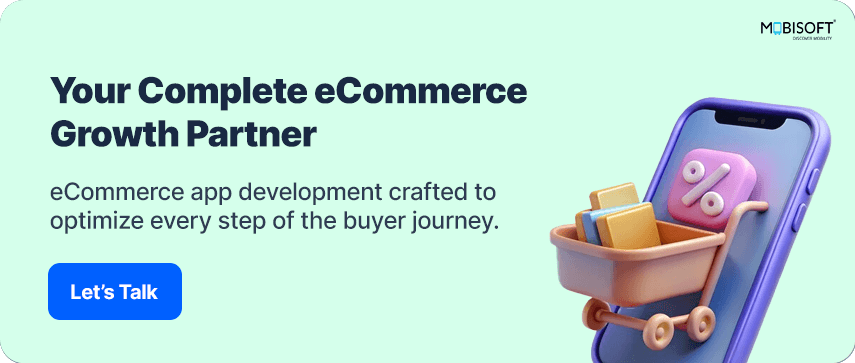
Key Expectations from E-commerce Support
| Customer Expectation | Impact on Purchase Decision |
| Response within 5 minutes | 78% more likely to complete a purchase |
| 24/7 availability | 72% of people favor companies providing around-the-clock assistance via AI chatbot tools |
| Multichannel communication | 64% anticipate flawless service across email, chat, and social media |
| Personalized recommendations | 80% more inclined to come back and purchase again. |
Source: Zendesk CX Trends 2024
Today, customer support automation transcends just issue resolution. Particularly in a competitive market, it is a major sales, retention, and customer satisfaction driver, making the integration of chatbot solutions in e-commerce more than just a trend.
The Role of Chatbots in Modern E-commerce
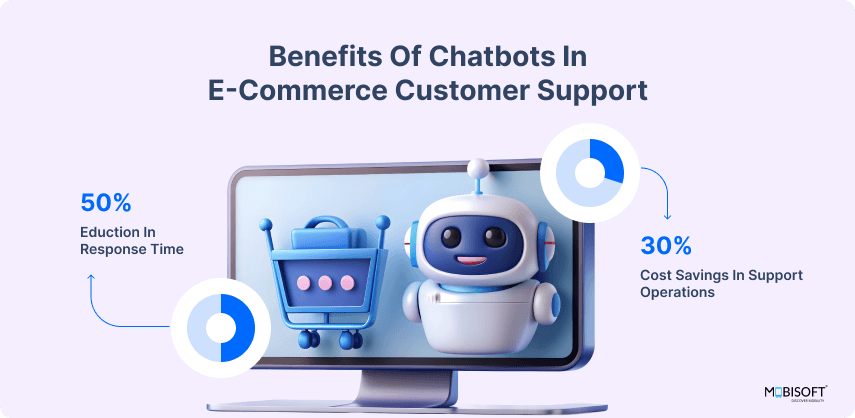
What Are Customer Service Chatbots and How Do They Work?
An artificial intelligence-powered chatbot able to converse with clients straight on your website, app, or messaging channels is a chatbot for e-commerce. Without a live agent, it resolves product inquiries, supports checkout, monitors orders, and even handles returns through customer support tools for e-commerce.
Unlike earlier bots that followed strict scripts, contemporary AI chatbots for customer service are far more sophisticated. To grasp context, draw knowledge from past interactions, and answer in a manner that seems conversational and intuitive, they apply Natural Language Processing (NLP) and Machine Learning (ML).
They get better on their own over time, offering scalable e-commerce automation tools and delivering increasingly personalized, real-time customer support experiences.
Why Chatbots Work for E-commerce Businesses Globally?
Not only for big corporations but also for expanding businesses and startups, chatbots for e-commerce have turned out to be a strong friend for internet merchants all throughout. Chatbots keep you accessible, reactive, and productive whether you're selling tech accessories in Jakarta or handcrafted items in Jaipur.
How they make a difference is this:
24/7 support across time zones
Sleep is not required by chatbots. Their immediate responses, at any time, make them perfect for e-commerce customer support across several time zones.
Cost-effective scalability
Businesses may utilize automated customer support bots that simultaneously handle thousands of conversations to drastically lower support expenses instead of hiring additional agents to keep pace with rising traffic.
Multilingual interactions
Language should not be an obstacle. Many AI chatbots for e-commerce now allow regional languages, therefore assisting companies in establishing rapport with local consumers in their preferred tongue.
Faster conversions and better retention
Chatbots enable reluctant buyers to finish their purchases more quickly by immediately answering queries on prices, inventory availability, or delivery times. By reducing friction during the buying journey, chatbots for scaling e-commerce businesses improve retention and boost conversions.
Juniper Research estimates that by 2025, businesses will save more than $8 billion yearly in customer support expenditures just by using chatbot solutions for e-commerce growth. That's an intelligent, scalable service rather than mere savings.
Source: Juniper Research Chatbot Report
How AI Customer Service Chatbots Deliver Business Value
Faster Response Times
Online consumers especially dislike waiting; still, no one likes waiting. Instant replies to FAQs from AI-powered chatbots save customers time in line for fundamental knowledge. This reduces dropoffs at checkout and improves customer happiness.
According to IBM, chatbots can completely answer up to 80% of typical customer inquiries, including product information, order status, or refund dates, without human interference.
Lower Operational Costs
Particularly around the holidays, keeping a large support crew costs money. Customer support automation through chatbots improves coverage while also saving money by removing the need for more staff. Around the clock, a single trained AI chatbot can take the place of dozens of agents. Companies save on salaries, training, and infrastructure without sacrificing quality.
Scalability Without Hiring
Customer questions could spike during times of major marketing or festival sales. Scaling a human team overnight is impossible. However, a chatbot platform for e-commerce can concurrently handle hundreds or even thousands of chats at no additional expense. You stay swift and alert even during traffic; therefore, your assistance won't fail when your sales rise.
Source: IBM AI Customer Support Stats
Top Use Cases for Customer Support Tools in E-Commerce
Order Tracking
E-commerce chatbots immediately show the order status, estimated delivery date, and courier information to customer requests like "Where's my order?", eliminating manual searches.
Product FAQs
From usage instructions, warranty terms, or product content, chatbots are able to provide immediate, correct responses based on e-commerce customer service software and product catalog information.
Return Policy Info
Rather than browsing website pages or sending an email to customer support, customers can just ask, "Can I return this product?" and receive an instant response. It’s a smoother experience enabled by AI chatbot features for customer support.
Payment or Refund Status
Customers tend to want to verify the success of their payment or check on the status of their refund. Customer support tools for e-commerce, like chatbots, can retrieve and show this information in one go with straightforward integrations.
Size Guide or Compatibility Checks
If there is uncertainty about whether a shoe fits true to size or if a cable is compatible with a specific device, chatbots are able to provide size charts, compatibility, or even direct users to helpful pictures during conversation.
Upselling or Cross-selling During Chat
Chatbots suggest add-ons like accessories or warranties during a purchase conversation. These suggestions appear naturally, based on what the customer is viewing, making the experience helpful and not pushy. It is a smart way to enhance sales with a shopping journey.
These features also contribute to AI personalization in ecommerce, helping customers receive tailored suggestions in real-time.
As estimated by Gartner, chatbots will be the main channel of support for 25% of organizations by 2027, a reflection of their growing role in the growth of AI in e-commerce customer service.
Source: Gartner Hype Cycle for AI 2023
Table: Global Chatbot Adoption by Region (Statista 2024)
| Region | Chatbot Adoption Rate in E-commerce | Primary Language Support |
| North America | 74% | English, Spanish |
| Europe | 68% | English, French, German |
| Asia-Pacific | 81% | Mandarin, Hindi, English |
| Latin America | 59% | Spanish, Portuguese |
| Middle East & Africa | 52% | Arabic, English |
Source: Statista Chatbot Survey 2024
With Asia-Pacific leading the charge, the table shows an increasing worldwide dependency on AI chatbot software for e-commerce customer service. Mobile-first attitudes and multilingual customer bases in India, China, and Southeast Asia fuel high adoption. Particularly as chatbot platforms for e-commerce increase language ability and local integrations, even areas with lower rates like Latin America or the Middle East are seeing consistent year-on-year growth.
Implementing AI Chatbots in E-Commerce: A Practical Global Guide

Implementing chatbots for e-commerce well calls for a step-by-step approach, whether you are serving a local niche audience or managing an international online store. How here:
Identify Use Cases
Begin by outlining the most common and repetitive customer touchpoints:
- Most questions concern delivery schedules or order tracking?
- Are you witnessing cart abandonment during off-hours when agents are offline?
- Do clients frequently inquire same policy or goods questions?
Identifying these typical interactions enables you to establish definite AI chatbot goals and design how the bot supports your e-commerce customer service staff.
Select a Platform
Not all chatbot platforms for e-commerce are created alike. Pick one appropriate for your region, scale, and technological stack. Here are some well-known and reliable names:
Tidio – Shopify, WordPress
Tidio is simple, inexpensive for beginners with Shopify and WooCommerce compatibility.
Intercom – SaaS, enterprise-level e-commerce
Intercom is perfect for subscription services or SaaS-driven e-commerce.
Drift – B2B focus
Drift is ideal for lead generation and upselling with a B2B-centered strategy.
Freshchat – Popular in India and Southeast Asia
Supporting omnichannel and multilingualism, Freshchat is quite popular in Southeast Asia and India.
LivePerson – AI-powered, multilingual
Deep NLP and WhatsApp integration provide for a strong enterprise-grade artificial intelligence chatbot.
If you're offering chatbot support within your mobile storefront or need real-time integration across app and web, choosing an ecommerce app development company can help align your app experience with chatbot features.
Look for:
- Multilingual support: Multilingual chat features especially for Asia, LATAM, and MENA regions.
- Integration with your e-commerce platform: Perfect plugin or API integration with your present e-commerce solution
- AI/NLP capability: Good Natural Language Processing (NLP) for conversational depth
- Omnichannel deployment (chat, WhatsApp, Messenger): On your website, WhatsApp, Messenger, and even Instagram DM, implement the same bot omnichannel.
Train and Customize Your Bot
The effectiveness of AI chatbots in e-commerce depends on how well they’re trained.. Build a useful bot by:
FAQs (shipping, payment, returns)
Include your most often asked questions: payment help, refund deadlines, and shipping times.
Product categories
Develop flows depending on product categories, e.g., electronics versus apparel, have different queries.
Regional nuances (like GST or local currency)
Regional tax details (such as GST), delivery zones, local language assistance, and money should all be included in your content.
These are essential considerations in custom ecommerce development, where chatbot features must align with unique workflows, region-specific requirements, and platform structure.
A personalized AI chatbot for customer support creates a more human-like, localized experience.
Go Live & Monitor
Launching your bot is only the beginning. Monitor your e-commerce automation tools for continuous improvement.
- Chat volume: Daily interaction with the bot by many users.
- Resolution rate: What proportion of questions get resolved without human involvement?
- Escalation to human agents: What frequency is the bot sending talks to a live agent?
- Customer satisfaction (CSAT) scores: What frequency is the bot sending chats to a live agent?
These ideas reveal flaws that might need human intervention or more automation, improve user journeys, and help fine-tune your bot's performance.
Case Study Snapshots
These real-world success stories reveal that chatbots transcend mere technological advancements; they serve as strategic instruments that significantly influence business performance, enhance customer experiences, and alleviate operational burdens.
US-Based Fashion Retailer
A mid-tier direct-to-consumer (DTC) fashion brand that serves mostly Gen Z and Millennial consumers deployed a Shopify-integrated chatbot on its website and mobile site.
Challenges Faced
- High volume of customers for size-related complaints
- Slow reactions in flash sales and new product launches
- Increased expenses of hiring personnel for the support group during the holiday season.
What they achieved
- Utilized a chatbot to provide size guide advice in real-time, tracking of orders, and return FAQs
- Integrated chatbot with CRM to suggest products based on previous purchases
Result
- A 65% volume decrease of support tickets within the first 60 days
- 18% boost in conversion rate from chatbot-initiated sessions
Impact
- Improved average query response time below 1 minute
The company now manages its high-volume campaigns without the need to add support personnel, thus providing a more scalable and responsive service to the consumer. You can explore a full fashion ecommerce transformation example here.
Middle Eastern Electronics Seller
An Arabic-speaking Middle East online shopping site focusing on electronics and mobile phones introduced bilingual chatbot features (English and Arabic) through WhatsApp and its website.
Problems Encountered
- Accumulating a backlog of work during new product launches
- Difficulty in the effective processing of multilingual queries
- Customer dissatisfaction was caused by longer waiting times.
What They Did
- Integrated WhatsApp chatbot along with product knowledge base to provide on-time, precise answers
- Applied smart routing to route high-priority problems to human agents who speak specific languages.
- Trained the bot to manage FAQs regarding payment plans, warranties, and shipping
Result
- $30K saved annually in support team costs
- Faster response time increased CSAT by 24%
Increased WhatsApp activity has resulted in 2.3 times higher completed purchases on the website.
Outcome
- With local language 24/7 support, the company enjoyed a pricing advantage in a price-sensitive and service-driven market.
Overcoming Common Concerns About Chatbots in Customer Support
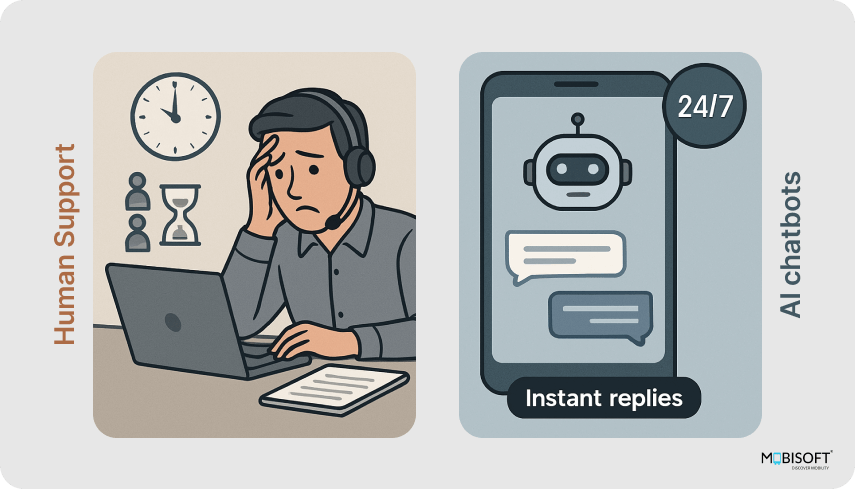
The majority of e-commerce business owners are hesitant to adopt chatbots, typically held back by archaic myths or cost and customer fear. Let's dispel some of these myths with facts:
| Myth | Reality |
| “It will feel impersonal.” | Modern AI robots leverage the use of Natural Language Processing to mimic human conversations. They can store customer preferences, greet customers by name, and answer in conversational modes, providing an intimate and intuitive experience. |
| “Too expensive for small firms.” | All these tools such as Tawk., Zoho SalesIQ, and Tidio have plans as low as ₹1,000/month with plug-and-play capabilities. No technical team needed. |
Measuring ROI: Chatbot Performance Metrics in Customer Support
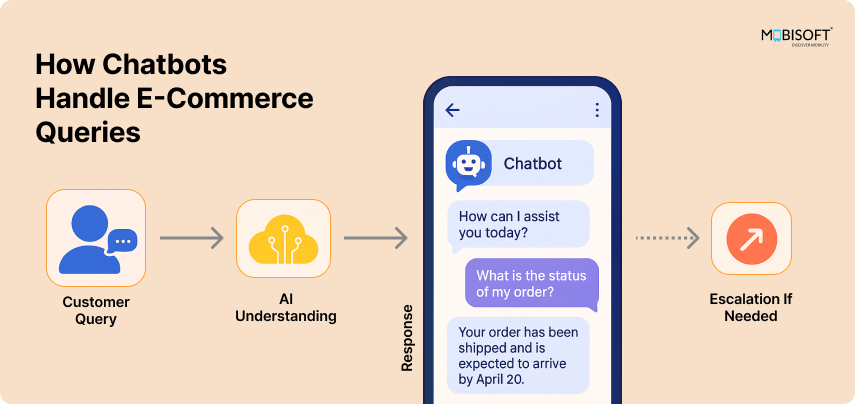
Investing in chatbot technology is more than merely answering automatically; it's about enhancing efficiency and reducing costs while enhancing the customer experience.
ROI Metrics to Track
| Metric | Pre-Chatbot | Post-Chatbot | Impact |
| Avg. First Response Time | 10 minutes | Instant | + Faster support, fewer dropoffs |
| Customer Service Cost / Order | $2.50 | $0.90 | - Cost reduction over 60% |
| Ticket Volume | 1000/month | 300/month | - 70% fewer escalations |
| CSAT Score | 78% | 91% | + Improved loyalty |
Tips to Maximize Chatbot Success Globally
It is a process that is assisted by iteration and localization.
- Support Multiple Languages: Maintain NLP-driven bots to learn customer dialects.
- Integrate with WhatsApp, Messenger, and Telegram for high-utilized regions.
- Update Scripts Frequently based on customer feedback.
- Ensure Seamless Escalation to human agents when required.
Conclusion: Chatbots as the Future of E-Commerce Customer Support
Chatbots are no longer just a buzzword; they’re a transformative customer support solution in e-commerce. With AI chatbots in customer service, you reduce costs, scale effortlessly, and deliver fast, personalized assistance.
With chatbot technology, you not only lower support costs. You boost customer satisfaction, grow easily, and build lasting brand loyalty. Whether you have consumers in Tokyo, Toronto, or Tunisia, immediate, courteous, and reliable customer service is now a reality.
Ready to discover the best chatbot for your business?
Let us help you choose a platform and strategy tailored to your global e-commerce needs.


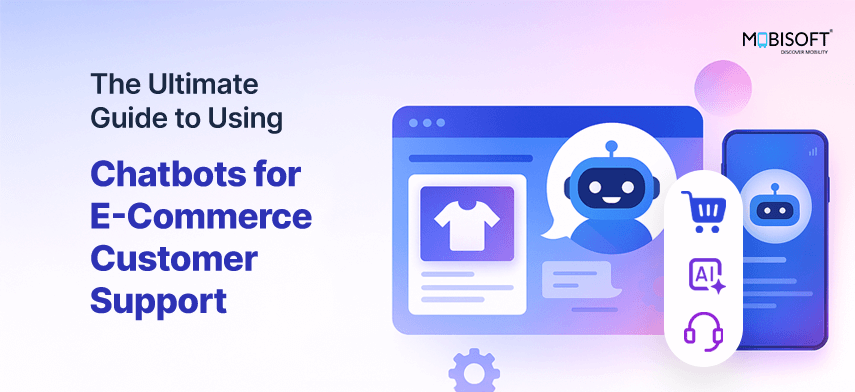


 July 17, 2025
July 17, 2025


